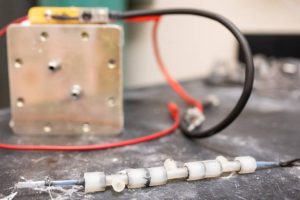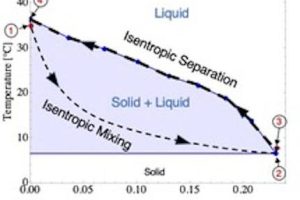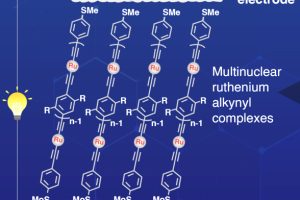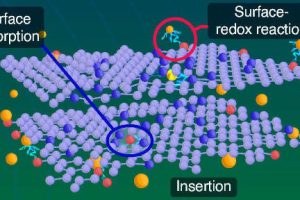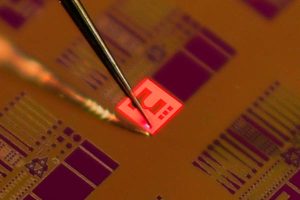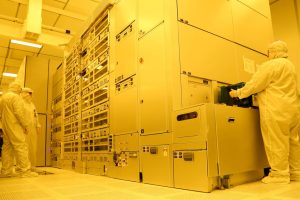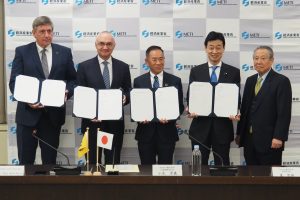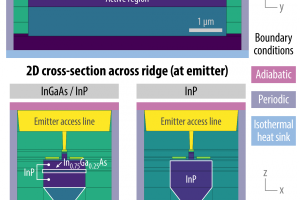Sub-millimeter microtubular (hollow fibre) bundled membranes could shrink the size of flow battery reactors, according to the Georgia Institute of Technology. In a proof-of-concept zinc-iodide battery, the reactor part achieved 306.1W/litre discharge and charging at 1,322W/litre. Key to the concept is using tubes-within-tubes to make the reaction vessel into a self-supporting structure – doing away with the volume-consuming support hardware ...
Research
The latest electronics research news from within the industry and universities from around the world.
Updated: Current-induced cooling shifts heat with ‘ionocaloric Stirling cycle’
Shunting ions around with electricity could produce enough heat transfer to replace greenhouse gas compression in domestic refrigerators, according to the US Lawrence Berkeley National Laboratory (LBL). The technology has been dubbed ‘ionocaloric cooling’. While warming and cooling a solid, liquid or gas can be used to shift some heat, much more can be shifted by a ‘phase change’ – ...
Molecular junction forms nano-scale thermoelectric harvester or thermometer
Molecular thermal energy harvesters or temperature sensors could be built from a particular organo-metallic material, according to scientists at the Tokyo Institute of Technology. “The team was curious as to whether multi-nuclear ruthenium alkynyl complexes based on multiple Ru(1,2-bis(diphenylphosphino)ethane)2 fragments could lead to more powerful molecular junctions, thanks to their unique electronic structure,” according to Tokyo Tech. Organo-metallic compounds with ...
Novel carbonaceous anodes prolong sodium ion battery life
Researchers from Korea and USA have developed an anode for sodium-ion batteries which can still store energy after 1,000 charge-discharge cycles, claims Pusan National University, which worked with the University of Illinois at Urbana Champaign. While sodium is cheaper than lithium, and sodium ion cells can theoretically store plenty of energy, potential electrode materials are not proving equal to the ...
Rallying cry from imec CEO
Imec CEO Luc Van den hove (pictured) has called for a renewal of the spirit of international cooperation which has driven the semiconductor industry’s extraordinary progress and could be harnessed to solve the world’s political challenges. “Throughout human history, working in unison and rallying our strengths has always paid off. It has allowed us to overcome challenge after challenge,” says ...
CES: Red micro-LED displays from AlInGaP aimed at AR glasses
Micledi Microdisplays has revealed red micro-LED demonstrators as CES today, using AlInGaP as a starting material. The spin-out from Belgian research lab Imec is aiming to make displays for augmented reality glasses, and is working on micro-LED displays in all three primary colours, including an alternative red display based on GaN. It also has proprietary micro-lenses that allow full-colour three-panel ...
NIST and AIM Photonics hook up on R&D
The U.S. Department of Commerce’s National Institute of Standards and Technology (NIST) has entered into an R&D cooperation research with AIM Photonics that will give chip developers a critical new tool for designing both opto and electrical iCs AIM Photonics, a Manufacturing USA institute, is a public-private partnership that accelerates the commercialisation of new technologies for manufacturing photonic chips. The ...
Imec and Rapidus sign up for 2nm
Imec and Rapidus, the Japanese government-backed semiconductor startup targeting 2nm processing, agreed a technology collaboration at a signing ceremony earlier this month in Tokyo. Pictured are: Jan Jambon, president of Flanders, Luc van den Hove, CEO Imec, Rapidus CEO Atsuyoshi Koike, Japan trade minister Yasutoshi Nishimura, and Rapidus chairman Tetsuo Higashi. Rapidus plans to mass-produce 2nm chips in Japan in ...
York, Bristol and Surrey universities share £28m O-RAN development grant
The universities of York, Bristol and Surrey are to share £28 million from the government to work with Ericsson, Nokia and Samsung on developing future O-RAN networking technologies. The universities will work with UK academics and industry players to ensure future network are designed to support O-RAN to promote a more diverse and innovative telecoms market. O-RAN enables operators to ...
Imec models 3D thermal transport in 5G/6G RF devices
Imec has presented a Monte Carlo Boltzmann modeling framework that uses microscopic heat carrier distributions to predict 3D thermal transport in advanced RF devices intended for 5G and 6G wireless communication for the first time. Case studies with GaN high-electron-mobility transistors (HEMTs) and InP heterojunction bipolar transistors (HBTs) revealed peak temperature rises that are up to three times larger than ...
 Electronics Weekly Electronics Design & Components Tech News
Electronics Weekly Electronics Design & Components Tech News
